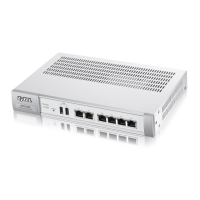NXC Series User’s Guide
147
CHAPTER 9
Interfaces
9.1 Interface Overview
Use these screens to configure the NXC’s interfaces.
• Ports are the physical ports to which you connect cables.
• Interfaces are used within the system operationally. You use them in configuring various features. An
interface also describes a network that is directly connected to the NXC. For example, You connect
the LAN network to the interface.
• Zones are groups of interfaces used to ease security policy configuration.
9.1.1 What You Can Do in this Chapter
• The Ethernet screens (Section 9.2 on page 148) configure the Ethernet interfaces. Ethernet interfaces
are the foundation for defining other interfaces and network policies.
• The VLAN screens (Section 9.3 on page 159) divide the physical network into multiple logical networks.
VLAN interfaces receive and send tagged frames. The NXC automatically adds or removes the tags
as needed.
• The LAG screens (Section 9.4 on page 167) combine multiple physical Ethernet interfaces into a single
logical interface.
9.1.2 What You Need to Know
The following terms and concepts may help as you read this chapter.
Interface Characteristics
Interfaces generally have the following characteristics (although not all characteristics apply to each
type of interface).
• An interface is a logical entity through which (layer-3) packets pass.
• An interface is bound to a physical port or another interface.
• Many interfaces can share the same physical port.
• An interface belongs to at most one zone.
• Many interfaces can belong to the same zone.
Types of Interfaces
You can create several types of interfaces in the NXC.
• Ethernet interfaces are the foundation for defining other interfaces and network policies.

